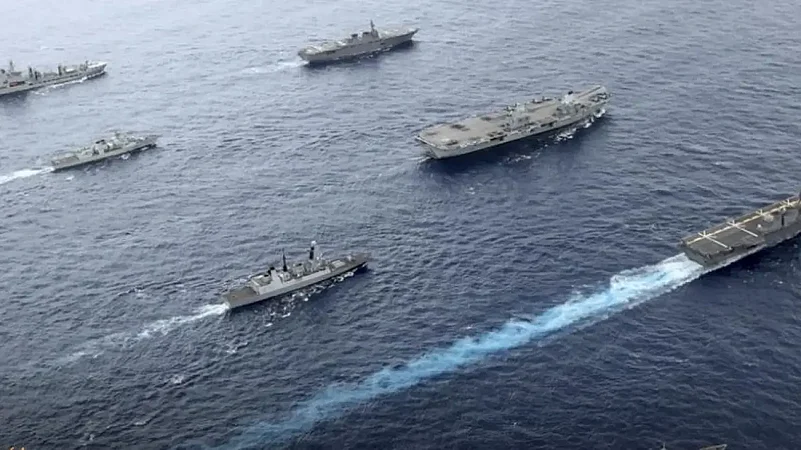While countries claim their land borders based on multiple considerations, the claim on the seas has been primarily limited to Exclusive Economic Zone (EEZ) which extends to 200 nautical miles from the baseline. The EEZ includes the territorial sea which extends to 12 nautical miles. While the countries have sovereign rights over the territorial sea, the EEZ provides them the right to existing natural resources. Various countries tend to violate or exploit these norms by laying claim to even uninhabited islands far from their shores. China has also laid claims to uninhabited islands in the South China Sea and has created artificial islands not only to extend its military power but its enhanced claims on the sea. China has made substantial claims in the South China sea, the East China sea and other areas of the Indo-Pacific based on its nine-dash Line and other extraneous considerations. These claims and regular efforts to extend its physical occupation have resulted in China following a new concept which can be termed as `maritime territorialisation’. While some other countries are also attempting to expand their maritime reach, China’s expansion is threatening and has adversely affected the interests of many South East Asian countries. The Chinese expansion can be seen through several zones.
Indo-Pacific
There are several regions which have not been clearly defined in a formal manner but are understood in generic terms, thus leading to divergent views based on the understanding and interpretation of different establishments. Like the Af-Pak region and Asia-Pacific region, the Indo-Pacific, which includes the Indian Ocean and the Pacific Ocean, also has similar connotations. One proposition identifies it from the West coast of the USA to the East coast of Africa, making it one of the most vibrant regions of the world as it includes more than half of the world population, more than one third of the world trade, third largest economic output and seven of the largest militaries of the world. It also has four most important US allies-- Japan, South Korea, Australia and India.
The USA had assumed the role of net security provider in the region but its diminishing impact after its withdrawal from Afghanistan gave the opportunity to China to enhance its presence in the region. It has advanced its claims in the South and East China Seas, and become more aggressive in its interface with other nations. It is also addressing its sensitivities through Malacca Straits by reinforcing Built and Road Initiative (BRI), which includes both land as well as maritime linkages. It’s forging ahead for the Taiwanese unification.
To counter the expansionist agenda and maritime territorialisation by China, the US has come up with an Indo-Pacific strategy. It has renamed the US Pacific command as the Indo-Pacific command. In addition, it has launched multiple groupings like QUAD (India, Japan, Australia and USA), AUKUS (Australia, UK and US) and IPEF, which includes 14 nations.
South-China Sea
This is the most contested area from China’s perspective. The South China Sea extends from the north of Singapore to the straits of Taiwan. It has an area of 3.5 million sq km and has multiple islands including the disputed islands of Paracels and Spratly. China has claimed more than 90 percent of the South China Sea based on the nine dash line claim. It has forcibly occupied Paracel Islands after conflict with Vietnam in 1974, whereas Spratly islands are partly controlled by Philippines, Taiwan and Vietnam.
For China, the South China Sea holds the second highest priority for territorial integration after Taiwan. Significantly, the concept of nine dash line was eleven dash line initially but two dashes were reduced as part of an agreement with Vietnam in 1952. This line was drawn by a Chinese geographer Yang Huairen in 1947, when the Republic of China was in power in China before it lost to the People's Republic of China during the civil war. Due to this reason, both the PRC as well as the ROC (Taiwan) now claim almost the entire South China Sea.
These nine dash lines are not geographical boundaries but are interpreted by China to advance its claims. China does not even honor the verdict of an international Tribunal which ruled in 2016 that there is no basis for the nine dash line to justify the claims of China on the South China Sea. The verdict was given when the Tribunal was approached by the Philippines. It also upheld the right of free navigation for all the countries of the world, a proposal advanced by the USA and India. Increasing inputs about huge oil and mineral reserves have emboldened China to make its claims.
East-China Sea
While China undertakes maritime territorialisation predominantly in the South China Sea, the East China Sea as part of the Indo-Pacific is also high on the Chinese agenda. Offshore from East China, it covers an area over one million sq Km and is bounded by ‘first island chain’. It has disputed Senkaku Island between China and Japan. The width of this sea is only 360 nautical miles but both China and Japan claim 220 nautical miles on account of EEZ, which is not possible mathematically. Though Senkaku islands have been controlled by Japan since 1895, China has been claiming these from 1970 onwards by citing historical reasons.
It is obvious that China has been using selective historical interpretation to advance its claims in Indo-Pacific, the South and East China seas. The Chinese salami slicing in maritime domain, the rejection by the tribunal of the nine dash line linked claims, the growing belligerence by North Korea have created a huge conflict potential in the Indo-Pacific. Since Taiwan’s integration is the primary agenda of China, the Indo-Pacific region is sitting on a potential spark. Cooperation is the best mode but the Chinese seem to be indulging only in conflict creation, whether it’s in the Indo-Pacific or in Eastern Ladakh.
The world has to take note of the Chinese expansionist agenda seriously and need to counter that effectively. A large number of areas have already been taken over by China, and it has also been carrying out huge repression of its own citizens. Any delay in cumulative response will be disastrous to say the least.
(The author, Major General (Dr) Ashok Kumar, is a Kargil war veteran, visiting fellow at Centre for Land Warfare Studies, and tweets @ChanakyaOracle)
Disclaimer- Views expressed are personal.





















